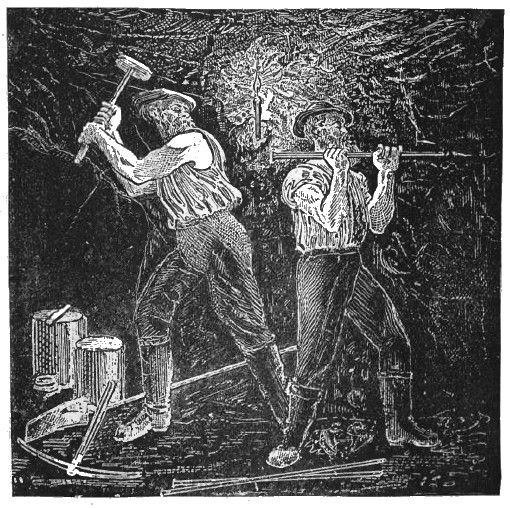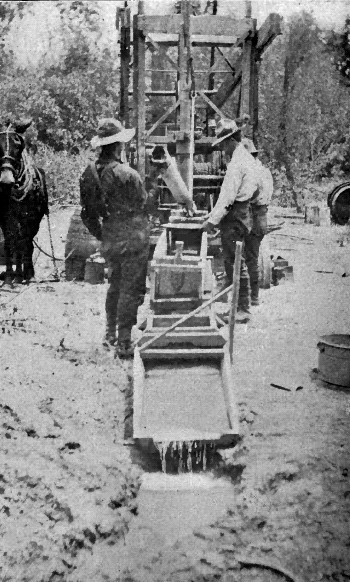In the meantime the extensive development of the goldfield has afforded an explanation for the checkered nature of the early explorations. It has been found that the quartzose lodes are uniformly poor, and that the rich ones have a chlorite and magnesian matrix which renders them susceptible to easy degradation and erosion. Thus it is easy to understand the current misunderstanding. The first veins worked were naturally those which had outcrops. They outcropped because they carried much quartz and were harder than the encasing country. They also happened to be poor; therefore the first attempts at mining were unprofitable. On the other hand the rich lodes had a composition into which calcite and magnesite entered largely, rendering them softer than the rock enclosing them, and therefore they suffered erosion at least as rapidly as the surrounding country. The detrital deposits of the surface capped the tops of the rich ore bodies, and it was not until an accidental exploration had pierced the cap of this "cement" that the first of the soft and rich lodes was uncovered. The discovery of the others followed in due course.
The idea of an enrichment in depth was based on the fact that the mines which were at first unprofitable became subsequently marvelous ore producers. Careless observation and that wishing which is father to much loose thinking served to bolster up an erroneous idea, and to spread the statement that the ore became richer at the water level. It is a matter which does not affect the reputation of the really good mines so much as that of the forlorn hopes, the poverty of which is excused by a lack of depth, thus leading directly to the spending of much money on the foundation of a fallacy.
From careful investigation and the sifting of much evidence I am forced to the conclusion that Kalgoorlie is no exception to a common experience, and that where rare enrichments occurred in the sinking of a shaft, the fact can be traced to the structural relations of the ore deposits. I regret the conclusion. It would have encouraged those in other regions had there at last been found a district where nature had placed the best ore where man could with most difficulty reach it, and, apart from its economic aspects, the occurrence would have been one of great scientific interest.Thus the tellurides, like rhodochrosite, tourmaline, sphalerite, pyrite and a host of other supposed indicative minerals, must be discarded as helps no better than the will-o'-the-wisp which leads the wanderer into a morass worse than the darkness itself. Better no guide at all than a false one.
Shareholders and investors may be tempted to inquire whether I would go so far as to deny the possibility of veterans in the profession having such ability and experience as would permit them to come to safe conclusions as to the prospective value of a mine from a mere examination into the character of the ore. To this I would answer that I believe the most experienced, the very Ulysses among mining engineers, would be the first to emphatically disclaim such short cuts to the valuation of mines. A moil and a 4-lb. hammer are of more use than a book full of sounding theories; a careful sampling of the workings is of more immediate utility than a treatise on mineralogy. Successful mining must be based on facts; all the rhetoric and fond imagining in the world cannot alter them. It is the province of the mining engineer to determine the facts, to get alongside them, as Huxley would say, and when a theory comes floating by leave it, as Joseph left his coat in the hands of the harlot, and flee. Experience has proved that indicative minerals are delusive; so let them go. But the mineral contents of a gold ore, though they have no bearing on the mining, decide its metallurgical treatment, and therefore need careful examination. The importance of the character of the ore from this point of view is too often overlooked by those enthusiastic mineralogists who permit themselves to make the most sweeping deductions on matters of much greater uncertainty.
Careful sampling is worth a bushel of suppositions, and the painstaking determination of the working costs is better than any amount of geological generalization. Mining is not a scientific pursuit; although at times it may to the observant have seemed to be either that or it is one big bit of insanity. But mining is an industry. The good sense which financial men have of late years contributed to its operations has done much to bring it from a windy mistiness to the solid footing of sound business The main purpose is not to develop the waste places of the earth, nor to spoil the scenery of the mountainous ones, but simply to win a profit by extracting ores out of the ground. It is a plain matter of profit and loss. On the one side is the value of the gold in the ore, and on the other is the cost of the processes needed to obtain it. To arrive at the former there is only one way, namely, to sample the workings systematically. The result will be reliable in proportion to the care taken. Any shirking of difficult places in the mine, any avoidance of hard portions of the vein, any assistance from untrustworthy hands, will vitiate the results. Against this must be placed the costs of operation. Here it is that experience is needed. The sampling is largely mechanical, like ordinary assaying, and requires patience and care more than anything else. In the estimate of the costs there must be included many items of expenditure, such as the breaking of the ore, the development work, the equipment, the milling, the management; and to arrive at these the previous actual charge of mines is the only proper preparation. Then comes the question of the quantity of ore available or likely to become available by further exploration. This is the pans asinorum of mining that which some describe as ore in sight is often really ore out of sight. The over sanguine estimation of ore reserves has rained more enterprises than all the bad management and over capitalization of which complaints are daily made. It is ever a difficult matter and requires a cool judgment, wide experience, and a careful investigation into the circumstances and structure of each particular mine.
When the value and tonnage of the ore available have been arrived at, and when working costs have been determined, then the engineer has the greater part of the evidence needed to submit to the client whom he is advising. The other data which will influence an opinion are more variable in their character. The geological conditions may affect the distribution of the ore bodies and, consequently, the cost of mining, and the mineralogical composition of the ore may determine the expense of milling. As such they mast not be overlooked, but the padding of a report with a large amount of geological disquisition, where it is not necessary to a comprehension of the facts of the case, is very nearly an impertinence, seeing that it is not expected that it will be understood by the person or persons for whose guidance the report is written. In concluding this contribution I would express the hope that this paper may lead to a useful discussion. If there are any technical men who seriously entertain the idea of an enrichment in depth due to the leaching of gold in the oxidized ores, then it would be of much service to the industry if they would frame a defense and an explanation of views which daily experience must otherwise condemn as nonsense. Nor in denouncing one generalization would I make the equally grave mistake of advocating itís opposite, namely, that all mines must necessarily become poorer in depth.
There may be causes, founded on geological structure, why a change in the value of the ore in a vein may take place in any direction, upward or downward, in dip or in strike, and it is an undoubted fact that there have been instances where the deepening of the workings has led to the discovery of new ore bodies. Bendigo is a telling illustration. The gold-bearing quartz occurs along the anticlinal axes of sedimentary rocks. In sinking, a succession of saddle formations is penetrated. No single one of these has any not able -vertical extent, yet the series as a whole is wonderfully persistent. This explains why the last resort of a perplexed mine manager is to advise the sinking of the main shaft. At Bendigo the advice is well founded, but when the managers from this district go to West Australia and recommend deeper exploration every time they encounter poor ore, they do so without regard to the total unlikeness of the conditions. Again, it cannot be denied that in certain regions alternations of comparative richness and poverty appear to coincide with the penetration of the workings through successive zones of rock. The Gympie district is a case in point. There the veins cut through a series of shales, limestones, conglomerates, and sandstones, amid which there are several beds of black slate. The gold occurs in paying quantity only when the veins are traversing the slates. Every district deserves a study unbiased by the record of its neighbors; each mine must be taken on its merits and inspected without prejudice.
It is, however, one thing to examine a mine with the assumption that gold veins in general become enriched in depth, and it is quite another thing to recognize that while it may occur in a particular case, it is an expectation which experience does not justify. When, however, such enrichment or impoverishment does occur, experience suggests to us that its cause is to be sought for rather in the geological structure of the encasing rocks than in the merely coincident presence of certain minerals found associated with the gold. One famous example of mineral enrichment is in South Dakota. The beginning of the mining industry of the Black Hills dates back to June, 1876, when the Wheeler brothers found rich gravel in Deadwood gulch. The outcrops of the large quartz lodes were early seen, but quickly discarded by the California and Montana miners, who ridiculed the idea of the profitable handling of ores which yielded on panning only from three to ten dollars per ton. After the placer-mines had commenced to yield handsomely, and while the quartz-lodes were unappreciated, the early mining activity was diverted to the development of the lowermost beds of the Potsdam formation, the gold of which lay in a conglomerate.
The Belt is that part of the region contiguous to the Homestake lode and its extensions, and reaching from Whitewood creek to Deadwood gulch. It is the center of the mining activity of the Black Hills, the only important mining region in the State of South Dakota. The ore occurs in large bodies of quartzified chlorite schist, conforming to the structure of the country and being a portion of it. The width of milling-ore varies from 50 to 400 feet. The uptilted edges of the gold-bearing schists are overlain by Cambrian sandstone. The latter, only a few feet thick at this point, is split by an intruding sheet of the porphyry which also overlies the whole formation and caps the hilltop. The lowermost member of the Cambrian series is a conglomerate, identified by its fossils as belonging to the Potsdam period, and said to have been derived from the degradation of the gold bearing lode under the outcrop of which it was formed by the seas of a very early geological time. These facts indicate for the Homestake vein an origin of remarkable geological antiquity.
Continue on To:
Minerals Which
Accompany Gold Ores, Part VI


